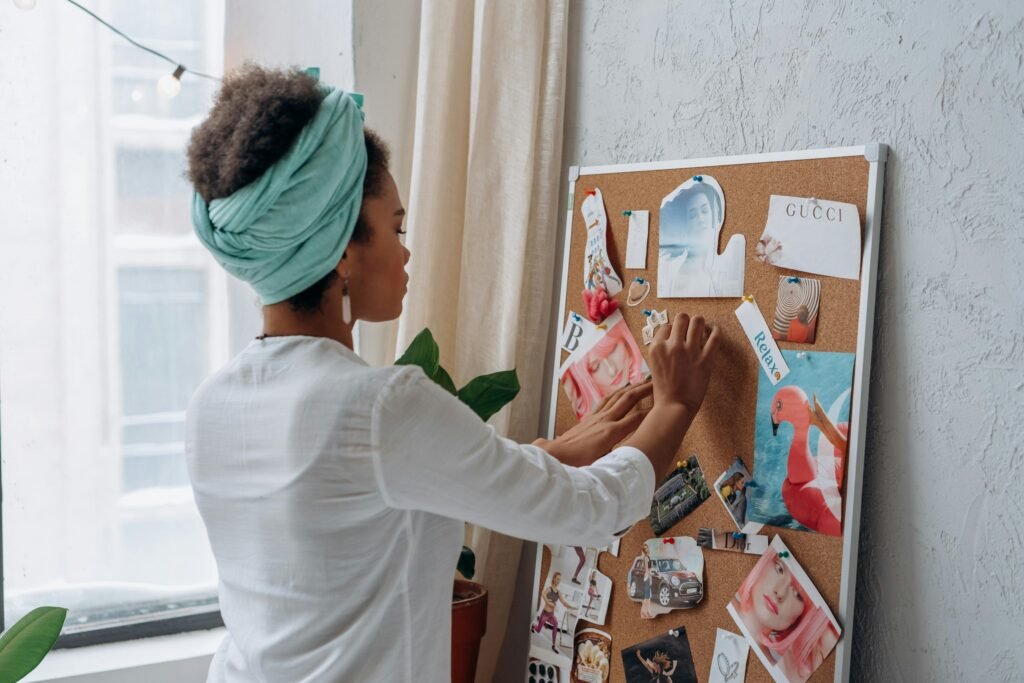Introduction to Vision Boards

Vision boards serve as powerful tools for visualization and goal-setting, designed to help individuals clarify their dreams and maintain focus on their aspirations. These boards are visual representations of personal goals, aspirations, or dreams, often composed of images, quotes, and phrases that resonate with an individual’s desires. By engaging with a vision board, a person is encouraged to keep their objectives at the forefront of their thoughts, creating a tangible connection to their ambitions.
The significance of vision boards lies in their ability to tap into the psychology of visualization; research suggests that visualizing a goal can enhance motivation and increase the likelihood of achieving desired outcomes. Creating a vision board allows individuals to dream vividly and articulate their hopes for the future, resulting in greater clarity regarding what they want to pursue.
Opting for a journal format to create a vision board further enhances this experience. A journal provides a personal and tactile medium for individuals to explore their creativity, reflecting their unique style and personality. Unlike digital formats, which may lack a personal touch, a journal invites deeper engagement through the act of writing, drawing, and crafting. This engagement fosters an emotional connection to the aspirations depicted, making the vision board a more meaningful artifact that individuals can revisit frequently.
Additionally, a journal vision board allows for an evolving landscape of dreams and goals, accommodating modifications as one progresses through life. This flexibility encourages continuous reflection and adaptation, transforming the vision board into not just a static display but a dynamic representation of personal growth and achievement. In essence, utilizing a journal for vision boarding merges creativity with introspection, offering an enriching approach to enhancing motivation and focus on one’s aspirations.
Gathering Materials for Your Vision Board
Creating a vision board in a journal requires careful selection of materials that will not only represent your aspirations but also reflect your unique personality. A good starting point is choosing the right journal; options vary from lined and blank notebooks to specially designed scrapbooks. Lined journals can help guide your thoughts if you prefer to write alongside your visuals, while blank pages provide unlimited creative freedom for design. For a more structured approach, consider a scrapbook, which allows for flexibility in layout and embellishment.
Next, consider the types of adhesives you will need for your vision board. Various options are available, including glue sticks, double-sided tape, and washi tape. Washi tape, in particular, is favored for its decorative qualities and easy removability, enabling you to rearrange elements without damaging your pages. For a more permanent solution, a good quality glue stick can securely affix images and other materials, ensuring longevity for your board.
Decorative elements play a crucial role in visual storytelling. Stickers, magazine cutouts, and printed images are excellent choices to enhance your vision board’s appeal. Additionally, incorporating art supplies like markers, colored pencils, or watercolors allows for personalization. Using vibrant colors can evoke emotions and set the mood, while hand-drawn illustrations can add a distinct touch that represents your artistic style.
As you gather your materials, remember to include items that symbolize your aspirations and values. These could range from quotes that inspire you to textures and patterns that bring joy. The outcome should be a colorful tapestry of your dreams, ambitions, and characteristics, ultimately serving as a motivational guide as you pursue your goals.
25 Different Ideas for Your Vision Board Layout

Creating a vision board in a journal is an inspiring way to visualize your goals and aspirations. Here are 25 creative layout ideas that can help you organize your thoughts and dreams effectively:
1. Thematic Pages:
Dedicate individual pages to specific themes such as career, health, relationships, or personal growth.
2. Dream Catcher Concept:
Arrange your images and goals in a circular spiral, mimicking the look of a dream catcher, with a central focus point representing your core aspiration.
3. Monthly Goals Sections:
Structure your vision board to reflect monthly goals, allowing for focused objectives over time.
4.Quote Overlay:
Layer motivational quotes over images in a creative manner, ensuring both elements complement each other visually.
5. Color-Coded Themes:
Utilize different colors for various aspects of your life, helping you to quickly identify areas of focus at a glance.
6. Timeline Layout:
Create a visual timeline of your goals, moving from past achievements to future aspirations, showcasing your growth.
7. Storyboarding:
Use panels or sections to tell a visual story of your journey, effectively illustrating where you are and where you want to be.
8. Visual Clusters:
Group related images and quotes together to create clusters, which can enhance the clarity of your vision board.
9. Collage Style:
Embrace traditional collage techniques by varying the sizes and orientations of images, creating a vibrant and dynamic layout.
10. Interactive Elements:
Incorporate pockets for notes or future ideas, adding a tactile layer to your vision board.
11. Mind Map Approach:
Design a mind map layout where the central goal radiates outward into various aspects of life.
12. Focal Image:
Choose a powerful central image with additional elements arranged around it, guiding the viewer’s attention to your main goal.
13. Grid Format:
Utilize a grid for a structured and organized approach, making it easy to visualize multiple goals side by side.
14. Nature-Inspired Layout:
Create organic shapes mimicking nature, such as leaves or waves, to infuse your vision board with a natural aesthetic.
15. Photo Frames:
Decorate your board with frame-like borders around images to create an inviting gallery feel.
16. Inspirational Pathway:
Build a pathway image that symbolizes your journey, with milestones represented along the way.
17. **Sentence Strips**:
Create sentence strips or tags featuring your aspirations, making them easy to read and inspiring.
18. Layering Technique:
Experiment with layering materials, such as fabric or textured paper, for a multi-dimensional effect.
19. Artistic Freeform:
Allow images and quotes to be arranged freely, resulting in a more spontaneous design reflecting your personality.
20. Symbolic Representation:
Use symbols, like stars or arrows, to represent your goals and create a mythical or inspirational tone.
21. Weekly Reflection Slots:
Incorporate sections for weekly reflections, allowing for recalibration of goals as needed.
22. Visual Affirmations:
Add visual affirmations alongside your images to reinforce positive thoughts related to your goals.
23. Mini Vision Boards:
Create miniatures of your larger goals that can easily fit on a single page, ideal for when space is limited.
24. Photographic Progress:
Include a space for before-and-after photographs that chronicles your journey towards achieving specific goals.
25. Mixed Media:
Combine sketches, magazine cut-outs, and printed photos for a unique and eclectic vision board layout.
These diverse ideas for your vision board layout can enhance creativity while helping you visualize and focus on your aspirations. By balancing imagery, quotes, and personal reflections, you can create an impactful tool for goal setting and personal growth.
Maintaining and Reflecting on Your Vision Board
Once you have created a vision board in your journal, it is crucial to prioritize its maintenance and reflection. Over time, our goals and aspirations may evolve, necessitating an update to the vision board to accurately reflect our current desires and ambitions. Regularly revisiting your vision board allows you to evaluate the progress you have made toward your goals and identify any new aspirations that may have emerged. This process ultimately cultivates a deeper connection with your personal growth journey.
Setting aside dedicated time for reflection can significantly enhance your engagement with the vision board. You may choose to incorporate this practice into a weekly or monthly routine, allowing you to assess your achievements, challenges, and shifts in perspective. During these reflection sessions, consider journaling about your experiences related to each goal depicted on the board. This can help solidify your commitment to your aspirations and track the evolution of your thoughts. Journaling not only enhances your understanding of your goals but also promotes self-awareness and healthy emotional processing.
Furthermore, as you achieve specific goals represented on the vision board, be sure to update it accordingly. Replace images or phrases that no longer resonate with your current journey, and introduce new elements that inspire you. By maintaining a dynamic vision board, you keep your dreams alive and relevant. Remember to integrate these check-ins and updates into your daily routine, as this will reinforce your commitment to personal growth. Engaging with your vision board regularly allows it to serve as not just a motivational tool but a reflection of your ever-evolving self. This continuous cycle of reflection, maintenance, and integration encourages a proactive approach to manifesting your aspirations.

